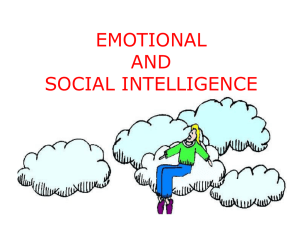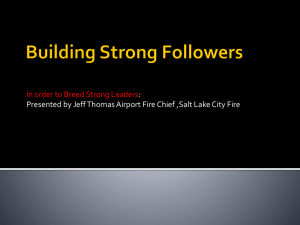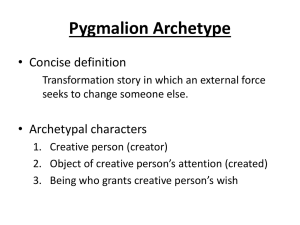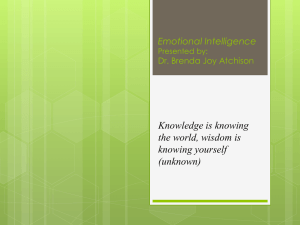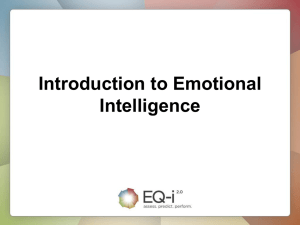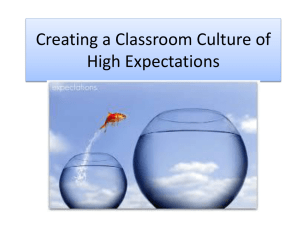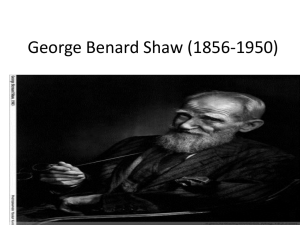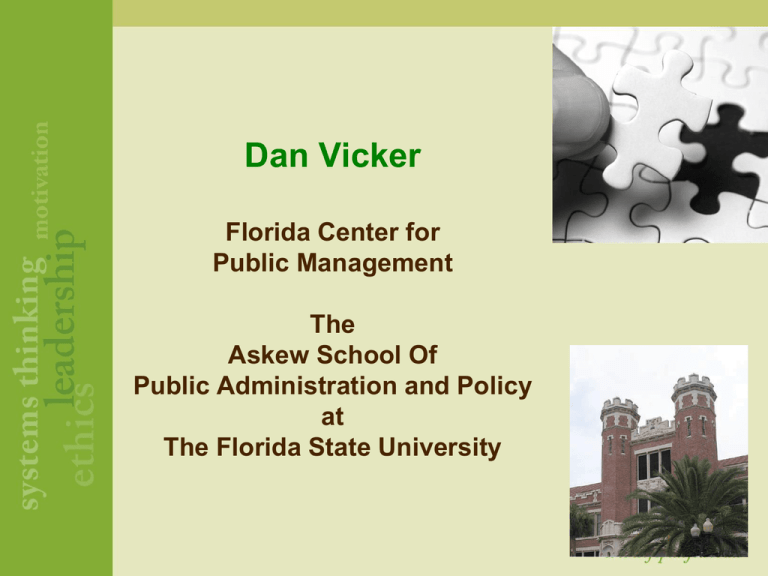
Dan Vicker
Florida Center for
Public Management
The
Askew School Of
Public Administration and Policy
at
The Florida State University
Level 1 Focuses On
Management One-on-one
Topics:
Transformational Leadership
Personal Style
Delegation
Motivation
Goal-setting
Performance Feedback
Coaching & Counseling
I compel you to watch these five
YouTube videos .
https://www.youtube.com/watch?v=jbkSRLYSojo&list=PL338F56B
0C64F940D
https://www.youtube.com/watch?v=kzCQ219bxl8&index=2&list=P
L338F56B0C64F940D
https://www.youtube.com/watch?v=u6XAPnuFjJc&list=PL338F56B
0C64F940D
https://www.youtube.com/watch?v=qp0HIF3SfI4&list=PL338F56B
0C64F940D&index=21
https://www.youtube.com/watch?v=G11t6XAIce0
Our World Is Changing
0 Globalization – Information, Industrial, Agriculture
0 The World Is Getting Flatter
0 Systems Orientation
0 Successful Organizations Run By Values Not By Rules
0 Leadership Inspires – Management Controls
0 Empowerment – Essential To Organizational Performance
0 Coaching – Essential to learning
Some Embrace Change Quickly,
Some Are Slow To Adapt.
Innate Innovators
Early Adopters
Late Adopters
Laggards
“The illiterate of the 21st century
will not be those who cannot
read and write,
but those who cannot
learn, unlearn, and relearn.”
Alvin Toffler
“Three things drive the need for learning
organizations, (Systems Thinking)
1. The Rapid Pace of Change
2. Ever increasing interdependence
3. Bureaucracies fail to tap the capacity of people.”
Peter Senge
Successful Organizations Of The Future
Will Be Those With High Social Intelligence
And That Improve Their Abilities To
Collaborate, Partner, And Chain Supply
Patterns To Innovate And Respond From
Command and Control Structures to
Collaborate and Connect Matrixes
Robert Katz – Effective Admin. Skills
Conceptual
Human
Technical
Operating Core
9
James Autry – Love & Profit
Transformational Leader
On top of good Administrative Skills
Honesty
Trust
Special
Treatment
Courage
10
Transformational Leadership
Traditional Leadership
Transformational Leadership
Sees people as source of problems;
blames them for poor performance
Sees the system as source of
problems; continuously improves
system processes
Emphasizes quantity of outputs
Emphasizes quality of service
Rule bound
Value driven
Supervises and corrects
Coaches and cheerleads
“Meddles” in people’s work
Helps people master work methods
“Tampers” with processes
Gathers trend data on processes
Sees turf battles as inevitable
Encourages and rewards cross
functional cooperation
Makes arbitrary decisions
Bases decisions on “objective data”
11
Transformational Leadership
Traditional Leadership
Transformational Leadership
l and inspections are main
Audits
guaranty of quality
Short-term focus
Emphasis on individuals with only a few
considered “winners”
Punishes mistakes, hides or rationalizes
problems
Improvement of work processes is
the key to quality
Long-term focus
Development of intact work groups
where everyone can be a “winner”
Encourages discussion of problems
and sees mistakes as learning
opportunities
Issues orders
Involves people in decision making
Protects image of always being right and Is willing to admit error and then
“on top of things”
search for a better way
Relies on extrinsic motivation; money
Emphasizes intrinsic motivation;
and other incentives
pride in performance
Primary emphasis is on control
Primary emphasis is on learning
12
X
McGregor's Theory X and Y
A belief that people are
fundamentally lazy and
try to get out of work.
A belief that people are
externally motivated.
Actions based on a
theory X belief result
in developing a culture
of compliance
Y
A belief that people are
fundamentally responsible and
view work as natural as play.
A belief that people are
internally motivated.
Actions based on a
theory Y belief result
in developing a culture
of commitment
“We smile at Southwest Airlines because we want to, not because we have to.”
“Your people come first, and if you treat them right, they’ll treat the outcomes right”
Herb Kelleher, Southwest Airlines
13
Herb Kelleher
Its So Simple!
1. People first - "The business of business is people."
2. Be humble
3. Work harder than anyone else and keep at it
4. Goodwill is sometimes worth more than winning
5. Continued learning
http://bornleader.net/2011/10/30/leadership-upside-down-herb-kelleher-style/
Understanding – Motivation
Daniel Pink: Workplace Engagement
“DRIVE: The Surprising Truth About What Motivates Us.”
Autonomy
Personal Mastery
And Purpose
“Everybody at their level wants some control. They want to matter,
and they want to make a difference.”
General Bill Creech
Understanding – Empowerment
Its Simple!
When You Engage People in
organizational decisions, you develop their
ownership in the organization and this
begets a culture of commitment.
Three Types of Employees
Engaged
NotEngaged
Actively
Disengaged
• Work with passion, feel a profound connection to the
company, drive innovation, move organization forward.
• Essentially “checked-out.” Sleepwalk through the day,
putting in time, but not energy or passion.
• Not just unhappy; busy all day acting out their
unhappiness; undermine what engaged coworkers
accomplish.
© 2011 Cengage Learning. All Rights Reserved.
Blake & Mouton – Managerial Grid
High
Relationship
Y
High
Task
X
18
Blanchard - Situational Leadership
R
e
l
Compelling a
t
i
o
n
Commitment s
h
i
p
Participating 3 2 Selling
Persuasive
Delegation
Telling
4
1 Compliance
R4
Task
R3 R2
R1
19
Why Don’t People Delegate
0 Quality
0 Easy to do myself
0 Fear
0 Control (loss)
0 Trust the outcome
0 Fear of dumping
0 Fairness
0 I’m responsible
0 No initiation
0 Equity
0 Lack of skills
0 Lack of willingness
0 They are too busy
0 Don’t know how
0 Overload
0 Timid
0 I own it
0 Work ethic
0 Power
20
The Power Of Words
“First, Break All the Rules: What the World's
Greatest Managers Do Differently”
Marcus Buckingham and Curt Coffman
People need
recognition for good
work every seven days
“Outstanding leaders go out of their
way to boost the self-esteem of their
personnel. If people believe in
themselves, it’s amazing what they
can accomplish”
Sam Walton
Essentials of Encouraging The Heart
James M. Kouzes and Barry Z. Posner
1. Set Clear Standards
2. Expect The Best
3. Pay Attention
4. Personalize Recognition
5. Tell The Story
6. Celebrate Together
7. Set The Example
Leadership Influence
Direct management influence may be divided into two forms:
0Coaching involves building on strengths
0Counseling involves correcting behavior
Coaching vs. Counseling
Lack of
Knowledge
of Superordinate
Goals & Values
Personal
Problem
Performance
or
Attitude
Opportunity
Performance
or
Attitude
Problem
Coach
Counsel
Coaching
A directive process by a manager to
train & orient an employee
to the realities of the workplace
and to help the employee
remove barriers to
optimum work progress
Counseling
A supportive process by a manager to
help an employee
define and work through
personal problems
that affect job performance
“Like incompetent doctors,
incompetent managers can make
life worse, make
people sicker
and less vital”
Warren Bennis
“We are being judged by a
new yardstick; not just how
smart we are, or by our
training and expertise, but
also how well we handle
ourselves and each other.”
Daniel Goleman, Ph.D.
Working with
Emotional Intelligence
What is Emotional Intelligence?
Emotional intelligence is not about being nice all the time.
• It is about being honest.
Emotional intelligence is not about being “touchy-feely.”
• It is about being aware of your feelings, and those of
others.
Emotional intelligence is not about being emotional.
• It is about being smart with your emotions.
The Five Essential Competencies of
Emotional Intelligence
• Self-Awareness
• Self-Regulation
Relate to Ourselves
• Self-Motivation
• Empathy
• Effective Relationships
Relate to Others
“If you understand your own feelings
you get a really great handle
on how you’re going to interact
and perform with others…
So one of the first starting
points is, ‘what’s going on
inside of me?’”
Chuck Wolfe
President,
C. J. Wolfe Associates, LLC
Practicing Self-Awareness:
• Awareness of our own emotional states is the
foundation of all the E.I. skills.
• Learn to “tune-in” to your emotions – they can give
you valid information about your responses to stressful
situations.
• Recognize the importance of emotions even in
“technical” fields.
“If we are in a heightened state
of agitation or anger we cannot
make good decisions,
we cannot reason well.”
Christine Casper
Communication, Motivation
& Management Inc.
Practicing Self-Regulation:
• Accept responsibility for choosing your own emotional
responses.
• Learn to “reframe” stressful situations into ones that
are challenging.
• Be aware of, and learn to manage, your own emotional
“triggers.”
“High performers are those who are
able to see with some clarity
to what degree they are
responsible for a setback and
to what degree it may be
circumstance or other people,
and as a result they are
able to be more persistent.”
Dr. J.P. Pawliw-Fry
Co-Director,
Inst. For Health & Human Potential
Practicing Self-Motivation:
• Recognize that emotions affect your performance.
• Identify your “explanatory style.” When a setback
strikes, resist asking “what’s wrong with me?” Instead,
ask “what can I fix?”
• Work to achieve your “flow state,” being in the moment
with work tasks.
“If people will stop for a moment and put
themselves in another person’s shoes…
it will help them modify their
own behavior. It will help
them develop relationships
with those people.”
Darryl Grigg, Ed.D.
Co-Developer,
American Express Emotional Competence Program
Practicing Empathy:
• Empathy means recognizing, and responding
appropriately to, the emotions of others.
• By expressing empathy, you also create empathy in others.
• Realize that emotions impact such measurable goals as
productivity and safety.
Creating Effective Relationships:
Employ all your emotional competencies – awareness,
regulation, motivation, and empathy – to:
• Influence and persuade others.
• Build consensus and support for team goals.
• Motivate and inspire yourself and others to achieve
those goals.
Pygmalion Factor # 1 – Climate
(The kind of social and emotional mood we create for others)
“When we expect more favorable things of people, we create a more positive
interpersonal climate for them.”
Dr. Robert Rosenthal
Positive Pygmalion – Climate
(Good behaviors that communicate high expectations)
• Being verbally supportive and encouraging
• Providing positive non-verbal cues through
tone of voice, eye contact, facial expressions
and body posture or movements
• Helping a colleague, an employee or an
organization to set challenging goals
Pygmalion Factor # 2 – Input
(The amount of information we give others)
“We teach more to those from whom we expect more.”
Dr. Robert Rosenthal
Positive Pygmalion – Input
(Good behaviors that communicate high expectations)
• Spending “extra” time with someone
• Providing someone with ideas to follow
up on or additional sources of information
to use
• Giving enough resources or ideas without
“taking over” the assignment
Pygmalion Factor #3 – Output
(The amount of input we encourage from others)
“We give more opportunity to those for whom we have more
favorable expectations to express their questions.”
Dr. Robert Rosenthal
Positive Pygmalion – Output
(Good behaviors that communicate high expectations)
• Assigning new, varying, multiple or
incrementally challenging assignments
• Providing opportunities (e.g., training,
projects) to learn or practice skills
• Providing exposure to and visibility within
other areas or departments (especially
upward in the organization)
Pygmalion Factor # 4 – Feedback
(The information we give others in regards to their performance)
“Managers give more positive reinforcement to high-expectation employees.
They praise them more for good work and criticize them less for making
mistakes. Consequently, their confidence grows.”
Dr. Robert Rosenthal
Positive Pygmalion – Feedback
(Good behaviors that communicate high expectations)
• Providing helpful suggestions on how
someone might be able to improve their
performance
• Regularly reinforcing desirable behaviors
with praise, recognition or rewards that are
sincere and specific
• Reinforcing your belief in their ability to do
better and your desire to see them succeed
Understanding – Team Process
Teams Go Through Four Distinct Phases
Understand That These Phases Are Necessary
How Groups Become Teams
Forming
Storming
Norming
Performing
58
The Five Dysfunctions of a
Team, Patrick Lencioni.
Bibliography
Autry, James A. Love & Profit: The Art of Caring Leadership.
Buckingham, Marcus and Curt Coffman. First, Break All The Rules: What The World's Greatest Managers Do Differently.
Bennis, Warren. On Becoming A Leader.
Bennis, W. Managing people is like herding cats.
Bennis, W. Why leaders can't lead: The unconscious conspiracy continues.
Blake, Robert R. and Anne Adams McCanse. Leadership Dilemmas--Grid Solutions..
Covey, Stephen R. Principle-Centered Leadership.
Gardner, John W. On Leadership.
Goleman, Daniel, Richard Boyatzis, and Annie McKee. Primal Leadership: Realizing the Power of Emotional Intelligence.
Greenleaf, Robert K., Don M. Frick and Larry C. Spears (editors). On Becoming A Servant Leader.
Hickman, Craig R. Mind Of A Manager: Soul Of A Leader.
Kouzes, James M. and Barry Z. Posner. The Leadership Challenge
Kouzes, James M. and Barry Z. Posner. Encouraging The Heart.
Lencioni, Patrick. The Advantage
Lencioni, Patrick. The Five Dysfunctions of a Team.
Myers, Isabel Briggs and Peter B. Myers. Gifts Differing : Understanding Personality Type.
Ryan, Kathleen, D., and Daniel K. Oestreich. Driving Fear Out Of The Workplace: Creating The High-Trust, HighPerformance Organization.
Scholtes, Peter R. The Leader’s Handbook: Making Things Happen, Getting Things Done.
Scholtes, Peter R., Joiner, Brian L. and Streibel, Barbara J, The Team Handbook.
Senge, Peter. The Fifth Discipline
Tom Peters, Re-imagine
60
Summary of CPM Levels 2 through 8 on
the following Slides.
61
Level 2 Expands The Focus To
Groups And Teams
Topics:
Group Dynamics
Conflict
Team Leadership
False Consensus
Problem-solving
Decision Making
Process Improvement
Level 3 Emphasizes
Organizational Issues
Topics:
Productivity & Quality
Organizational Communication
Information Technology
Emotional Intelligence
The Sterling Process
Project Management
Level 4 Deals With Big Picture
Organizational Issues
Topics:
Power
Ethics
Organizational Culture
Organizational Change
Level 5 Examines How
Government Must Adapt To
The Future
Topics:
Social Change And Its Impact On
Public Management
Generations At Work
Changing Values In America
Strategic Planning And Budgeting
Organizational Designs For The
Future
Organizational Dynamics
Level 6 Teaches The
Systems Approach To
Management
Topics:
Systems Thinking
Real-world Applications Of
Systems Thinking
Level 7 Is An In-depth
Seminar On Public Policy
Topics:
Policy Development
Policy Argument & Critique
Policy Models
Policy Presentations
Level 8 Is The CPM
Graduation Class, Held
Annually.
Organized Around Break-out
Sessions, Presenters Discuss
The Latest Issues In Public
Management And The
Application Of CPM
Principles In Real Life.
The Final Day Is The
Graduation Ceremony.

